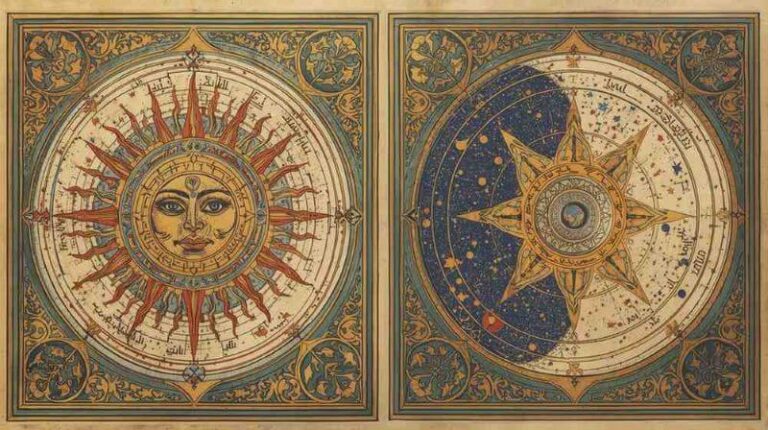Arabic Dots - The Bridge Between Astrology And Inner Psychology
Arabic Dots – The Bridge Between Astrology And Inner Psychology
Arabic points (also known as Arabic parts or Arabic Lots ) represent mathematical points that are calculated based on the Ascendant and the position of the planets in the birth chart. They do not act like the planets, but represent the synthesis and projection of their mutual relations , a kind of central point of experience . They are activated when they are affected by transits or progressions, so their influence is revealed at key moments in life.
The roots of Arabic dots go deep into ancient Babylonian, Egyptian and Hermetic astrology. In the Hellenistic period (1st century, Dorotheus of Sidon) they became standard practice and were known as “Lots.” After the fall of Rome, Arab and Persian scholars continued to cultivate and develop this technique. The Persian astrologer Abu Ma’shar (787–886) described at least 55 different points. Around the 10th century, they began to be translated into Latin, so European astrologers, such as Bonatius in the 13th century, mistakenly assumed that they originated in Arabia – hence the name “Arabian Points.”
In technical terms, Arabic points function similarly to midpoints. They do not actively aspect , but only receive aspects from planets, angles, transits, progressions, solar arcs and fixed stars. Conjunction and opposition are the strongest, while trine, square and inconjunction (quincunx) become important if they fit into the nature of the point itself. A particularly strong influence arises when the ruler of the sign in which the dot is in true aspect with her.
When working with Arabic points, it is important to pay attention to the following:
conjunction with an angle or planet, aspects of the ruler of the point to the point,
cluster (multiple points in the same field), the presence of a planet that participated in the calculation of the point, the element of the sign in which the point is located (gives important insight).
Therefore, Arabic points are not static, but represent potential hubs of experience that are awakened at certain moments in life. They show where the inner dialogue between the ego and the unconscious takes place, where crises, gaps and fulfillments arise.
Arabic points and psychological meaning
When we look at Arabic points from the point of view of psychology and especially Jungian analysis, they become archetypal landscapes of the soul . Fortune and Spirit, as the basic points, set the polarity between need and fulfillment, while the others differentiate different forms of love, loss, limitation, victory and courage.
Below is a detailed elaboration of the most important Arabic points:
Part of Fortune (Fortuna) – Moon
Formula: Asc + Moon – Sun
Fortune is hunger, longing, inner emptiness. It does not speak about wealth in the material sense, but about the psychological need to receive and fulfill ourselves. It shows where we feel that “a part of us is missing” and where we search for an experience that can fulfill us.
Psychological meaning:
Feeling of emptiness, need, search. Fortune reminds us that the feeling of lack is an integral part of human existence.
Jungian aspect:
Fortune is the archetype of the Seeker – the eternal search for the lost whole Self. Its shadow is dependence on external objects or people. In the process of individuation, it teaches us that inner wealth does not come from without, but from within.
Part of Spirit (Spiritus) – Sun
Formula: Asc + Sun – Moon
Spirit is the opposite of Fortune: it is not emptiness, but fulfillment and the ability to give. It shows where we have the inner strength to express and give the gift of who we are.
Psychological meaning:
Feeling of peace, self-sufficiency, creativity.
Jungian aspect:
Spirit is the archetype of the Creator, the light that pours out. The shadow of Spirit is grandiosity and the belief that we don’t have to receive anything. In individuation it teaches us that there is a balance between receiving (Fortune) and giving (Spirit).
Part of Love – Venus
Formula: Asc + Spirit – Fortuna (Al Biruni)
This point speaks of union, beauty and harmony. It represents the experience of love, not only romantic, but also spiritual and aesthetic.
Psychological meaning:
Feeling of peace, tranquility, belonging, in love.
Jungian Aspect:
Archetype of the Lover. The shadow manifests itself as an obsession or a loss of boundaries. In the process of individuation, it teaches us that love is not only fusion, but also the conscious recognition of beauty and harmony.
Part of Despair (Despair/ Necessity) – Mercury
Formula: Asc + Fortuna – Spirit (Al Biruni)
This point represents decisions, losses and inevitable compromises. It confronts us with the fact that we cannot have everything and that it is necessary to let go of what we love in order to move on.
Psychological meaning:
Restlessness, disappointment, parting, but also learning acceptance and flexibility.
Jungian Aspect:
Archetype of the Traveler at the Crossroads . Shadow – paralysis in decision-making. In the process of individuation, Despair teaches us that every loss opens the door to a new path.
Part of Captivity – Saturn
Formula: Asc + Fortune – Saturn
This point indicates limitations and a sense of confinement. But it is through Saturn – discipline and facing reality – that we discover the path to liberation.
Psychological meaning:
The feeling of restraint, obstacles, but also the possibility to find inner strength through the boundaries.
Jungian aspect:
Archetype of the Old Man / Shadow of the Father . The shadow is identification with the role of victim. In individuation it teaches us that by accepting limitations we actually find freedom.
Part of Victory – Jupiter
Formula: Asc + Jupiter – Spirit
This point brings gifts and grace. The victory here is not over others, but over our own limitations and the feeling that we are part of a wider harmony.
Psychological meaning:
Joy, gratitude, feeling blessed.
Jungian aspect: King / Benefactor
archetype . Shadow – a sense of entitlement and dependence on external happiness. In the process of individuation, it teaches us gratitude and generosity.
Part of Courage – Mars
Formula: Asc + Fortuna – Mars
This point shows the moments when we have to do what is right, even if the ego is against it. It represents the inner strength and conscience that guides us through challenges.
Psychological meaning:
Steadfastness, fairness, inner strength.
Jungian Aspect: Warrior
Archetype . The shadow is blind aggression or stubbornness. In the process of individuation, Courage teaches us to act in accordance with inner truth , regardless of the cost.
Conclusion
Arabic points are not only technical calculations, but symbolic maps of the inner journey . Their strength is revealed at the moment when they are affected by transits and progressions, so they become focal points of life events and internal crises.
In Jungian terms, each point opens the door to an archetypal experience: from the Fortune-Spirit polarity, through love and despair, to captivity, victory and courage. They remind us that life is not a line of fulfillment, but a cycle of losses and gifts, limitations and liberation.
Through them we learn that the process of individuation takes place precisely in these inner tensions. Arabic dots become signposts to wholeness – they show where the unconscious invites us to confront and transform.
They are, in the end, maps of the soul : the inner landscapes through which we pass on the way to our own wholeness.

